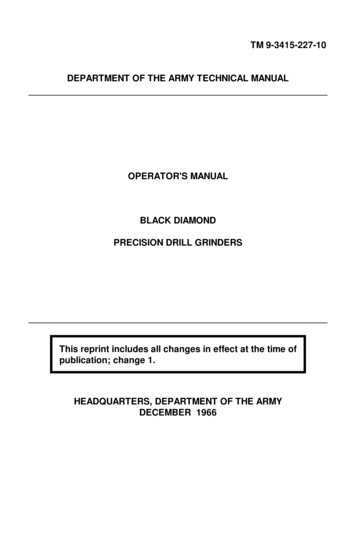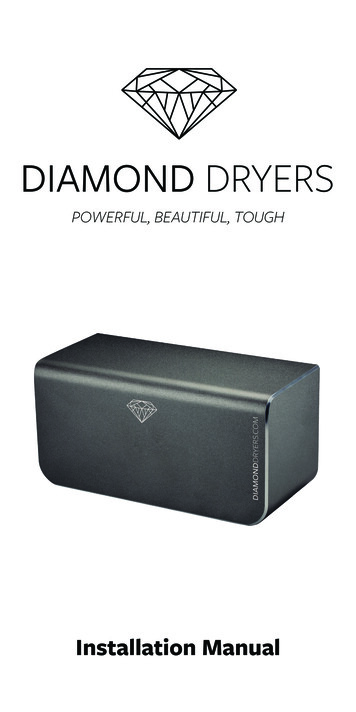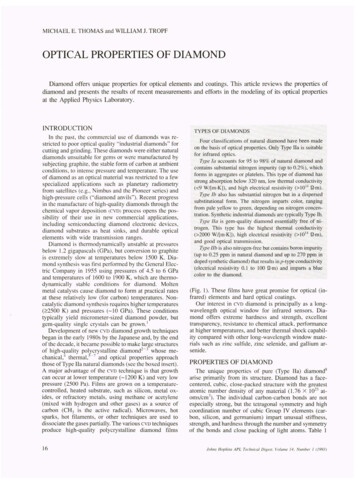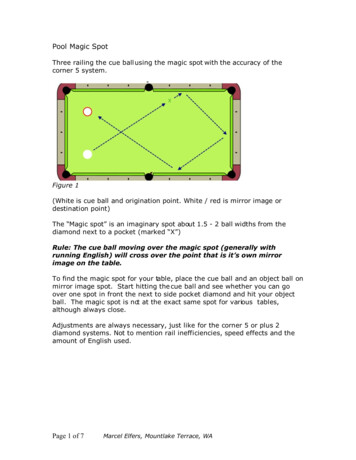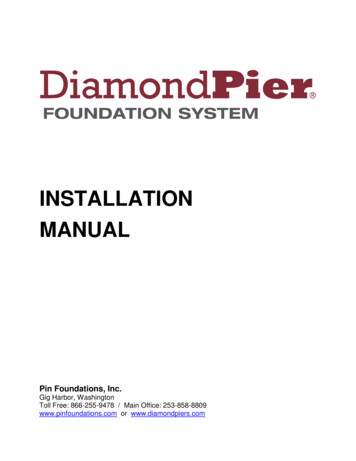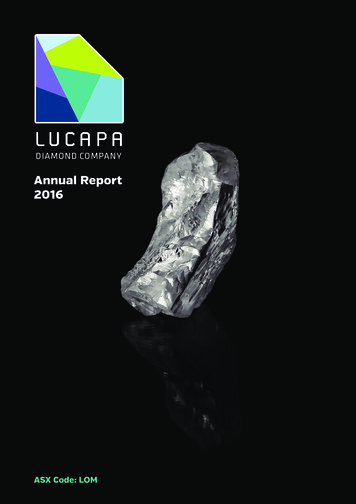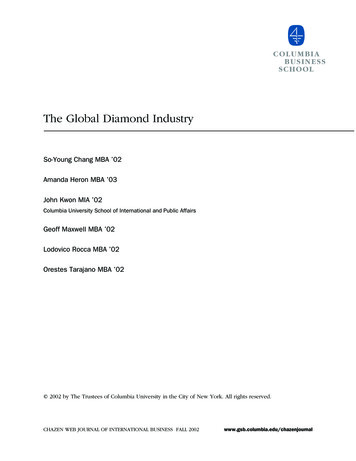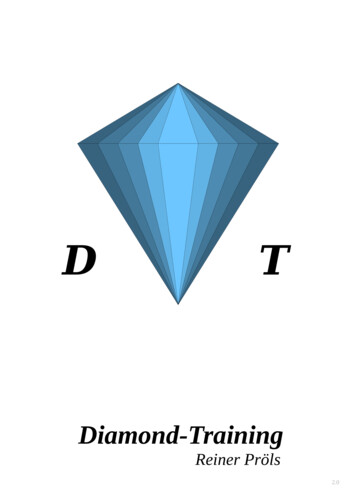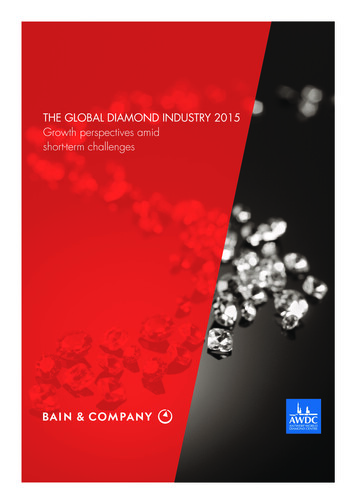
Transcription
THE GLOBAL DIAMOND INDUSTRY 2015Growth perspectives amidshort-term challenges
This work was commissioned by AWDC and prepared by Bain & Company. It is based on secondary market research, analysis of financial informationavailable or provided to Bain & Company and AWDC, and a range of interviews with customers, competitors and industry experts. Bain & Companyand AWDC have not independently verified this information and make no representation or warranty, express or implied, that such information is accurateor complete. Projected market and financial information, analyses and conclusions contained herein are based (unless sourced otherwise) on the informationdescribed above and on Bain & Company’s and AWDC’s judgment, and should not be construed as definitive forecasts or guarantees of future performanceor results. Neither Bain & Company nor AWDC nor any of their subsidiaries or their respective officers, directors, shareholders, employees or agents acceptany responsibility or liability with respect to this document. This document is copyright of Bain & Company, Inc. and AWDC and may not be published,copied or duplicated, in whole or in part, without the written permission of Bain & Company and AWDC.Copyright 2015 Bain & Company, Inc. All rights reserved.
The Global Diamond Report 2015 Bain & Company, Inc.ContentsNote to readers ii1.Recent developments in the diamond industry 12.Rough-diamond production 73.Cutting and polishing 134.Diamond jewelry retailing 175.A brief overview of industry challenges 236.Supply-demand balance through 2030 27Key contacts for the report 33Page i
The Global Diamond Report 2015 Bain & Company, Inc.Note to readersWelcome to the fifth annual report on the global diamond industry prepared by the Antwerp World DiamondCenter (AWDC) and Bain & Company.In this year’s edition, we take a comprehensive look at the year’s major developments along the diamond valuechain. We focus on the reasons for the recent drop in rough and polished prices against the backgroundof continued but slowing growth in the macro economy.As in previous years, we start with key developments along the value chain and a review of recent economicfundamentals that are the long-term drivers of diamond jewelry demand and prices.We look at the long- and short-term factors influencing prices to better understand the recent declines in polishedand rough-diamond prices and expectations for their recovery. We compare 2014 results with the results of previousyears and review the market to date in 2015, which has been marked by demand uncertainty and price declines.We also provide an update on the long-term outlook for the diamond industry through 2030. The 2030 supplydemand outlook is based on long-term macro-fundamental factors and incorporates the effects of the recentdecline in demand from China.Readers looking for a quick overview of the main messages and key takeaways of this report can find them below: In 2014 and the first half of 2015, revenue across the diamond industry value chain grew by 4 % to 8 %as demand has slowed in China while continuing to grow in the US. Despite a generally solid performance in 2014, the second half of that year and the first half of 2015 have been characterized by a degreeof uncertainty in the diamond industry. The primary source of this uncertainty is China’s slowing GDPgrowth, which we highlighted as a potential risk in a previous edition of this report. Greater China’sdiamond jewelry retail dynamics caused a decrease in demand for polished diamonds and, in turn, roughdiamonds. In addition, the jewelry consumption spike in the Chinese market in 2013 led to inflatedexpectations of further growth in demand for diamond jewelry that were not realized. These expectationsled to stock accumulation throughout the diamond pipeline, causing price declines for both polishedand rough diamonds. The Greater China diamond jewelry market appears to be in turbulence in the short term. By now, the threelargest retailers have posted significant year-over-year drops in diamond jewelry sales driven by the stockmarket crash and continued consumer uncertainty. In 2015, the diamond industry suffered the ripple effect from the mild decline in consumer demandfor diamond jewelry that started in 2014 in Greater China. That slowdown led to a notable drop in demandfor polished and rough diamonds, which in turn led to price decreases for polished and rough diamondsof 12 % and 23 %, respectively, since May 2014 and of 8 % and 15 %, respectively, since the beginning of 2015.The weaker-than-expected growth in customer demand initially affected demand for polished diamondsas retailers built up inventories and reduced purchases of polished diamonds. The slowdown then extendedto rough-diamond producers as mid-market companies built up their inventories and reduced their purchasesof rough diamonds despite declining prices. We believe that regular circulation of diamonds through the pipeline should be restored as soon as the midmarket and retail segments clear their excess inventories. This time, however, the market should return to itslong-term growth trajectory more quickly than is the historical norm because of positive macroeconomicfundamentals. Conscious management of supply levels by rough-diamond producers and polished-diamondmanufacturers, however, is necessary for a sustained recovery.Page ii
The Global Diamond Report 2015 Bain & Company, Inc. Amid industry turbulence and continuing pressure on the market, mid-market companies are being forcedto reevaluate their business models. At the moment, the segment is not robust enough to cushion againstshort-term fluctuations in the diamond jewelry retail market. The mid-market has little bargaining powerover rough producers and retailers and limited access to financing, yet mid-market players unconsciouslyor deliberately bear risks and benefits of price volatility that their business models cannot support. We observethat the continuing development of the mid-market segment should enable the industry to implement moresustainable business models. As in past years, the industry faces key challenges: sustaining long-term demand for diamonds in developedmarkets and among a new generation of consumers, and boosting demand from other sources than jewelryand aesthetic use. The risk of penetration of undisclosed synthetic diamonds persists; there is, however,no reason to believe that it will have any considerable impact on the market in the near future. One of the keyindustry priorities in 2016 for restoring a sustainable, healthy diamond pipeline will be to restore the midmarket segment’s profitability, which declined in 2014 and 2015 because of deteriorating demand for polisheddiamonds and excess inventories in the middle segment. The long-term outlook for the diamond market remains positive, with demand expected to outpace supplystarting in 2019. Until then, the rough-diamond supply-demand balance will be tight. We expect demandfor rough diamonds to recover from the recent downturn and return to a long-term growth trajectory of about3% to 4% per year on average, relying on strong fundamentals in the US and the continued growth of the middleclass in India and China. The supply of rough diamonds in value terms is expected to decline by 1% to 2% peryear through 2030.Page iii
1.Recent developmentsin the diamondindustry The year 2014 was another growth year for the diamondindustry. However, softening demand for diamond jewelryin the second half of 2014 translated to slower growthin the mid-market and retail segments. Softening retail demand continued into 2015, making its waydown the value chain, which led to falling prices and decreased rough-diamond sales. Cutters and polishers posted revenue growth in the midsingle digits in 2014, driven by low-cost players in Indiaand China amid continued multiyear decline in profitability. Retail sales of diamond jewelry grew 4 % in 2014 as solidUS sales offset the slowdown in China. The results of 2015to date indicate that the US market continues to grow whilethe Chinese market continues to slow. Despite the growth of the overall market, prices of polished andrough diamonds have fallen 12% and 23%, respectively, sinceMay 2014 and 8% and 15%, respectively, since the beginning of 2015, as short- and long-term factors have shapedprice dynamics. The short-term story of 2014 and 2015 centers on the buildupof stocks throughout the diamond pipeline. In the second halfof 2014, consumer demand for diamond jewelry fromGreater China was weaker than expected, which led retailers there to trim orders for polished diamonds and, in turn,to falling demand for polished diamonds and inventorybuildup in the cutting and polishing (C&P) segment. Scarcerfinancing for the mid-market segment compelled the mosttroubled players to unload inventory at lower prices, furtherpushing down the prices of polished stones. By the secondhalf of 2014, major producers were reducing rough pricingin reaction to weaker demand from the middle market. In the long term, both polished and rough prices are drivenby macroeconomic fundamentals that remain positive. Pricestook 18 to 24 months to rebound after the previous economic turmoil of 2001 and 2009. The current situation,featuring positive macroeconomic factors, is decidedly different. Prices are likely to recover faster this time as accumulated stocks are worked down, assuming consciousmanagement of production levels by rough-diamond producers and polished-diamond manufacturers as well as continued consumer demand.
The Global Diamond Report 2015 Bain & Company, Inc.Figure 1: Revenues across the diamond value chain posted continued growth in 2014 but slowed down in 2015Rough diamondsPolished diamondsRough-diamond salesDiamond jewelryCutting and polishingJewelry manufacturingRetail salesGlobal revenues by value-chain segment, 4% 4% 8% Y change 2013–2014YOY change 2014–2015E**Based on H1 2015 resultsNote: Jewelry manufacturing value is estimated at approximately 65% of retail sales based on the historic averageSources: Company data; Kimberley Process; Euromonitor; Bain analysisFigure 2: The industry’s profit has declined; the cutting and polishing and retail segments account for the lossRoughdiamondsRoughdiamondsalesPolished diamondsCutting and polishing(including trading)Diamond jewelryJewelrymanufacturingRetail salesAverage operating margin, 201423–26%10–13%3–5%0–3%Changein profitability2014 vs. 20134–6%retailersSmallSmallretailers( 65%( 65%the retailmarket)of theofretailmarket)LargeLargeretailersretailers( 35% of( 35%of the retailtheretailmarket)market)Rectangle widthcorrespondsto segment revenuein 2014Expected changein profitability2015 vs. 2014Notes: Analysis of exploration and production is based on data for De Beers, ALROSA, Rio Tinto, Dominion Diamond, Petra Diamonds;analysis of large chains is based on data for Blue Nile, Chow Sang Sang, Chow Tai Fook, Gitanjali, LVMH, Michael Hill, Richemont, Signet Jewelers, Tanishq, Tiffany & Co.Sources: Publication analysis; company data; expert interviews; Bain analysisPage 3
The Global Diamond Report 2015 Bain & Company, Inc.Figure 3: The profit squeeze began when slowing demand led Chinese retailers to accumulate moreinventory than usualYOY change(H2 2013–H2 2014)Inventory of Chinese diamond jewelry retailers*, days400 16%300281316321H1 2014H2 20142762422312001000H1 2012H2 2012H1 2013H2 2013*Estimated based on selected companies accounting for 50% Chinese diamond jewelry retail salesNote: Inventory is shown as of end of period; for some companies included in the analysis, fiscal year ends on March 31Source: Company dataFigure 4: Inventory accumulation led to a fall in polished prices starting in 2014, with rough prices followingPolished-diamond price index, 2004 price 100Rough-diamond price index, 2004 100250200CAGR 6% 3%CAGR 2%-2%-8%200150Polisheddiamonds150 1% 3%CAGR 12%100-15%100CAGR 4%502004200520062007200820092010201120122013CAGR for 2004–2007 and 2008–2011, YOY change for 2012–2014, 9M change for 2015Note: The CAGR for polished-diamond prices is calculated as the growth rate for year-end or period-end pricesSources: WWW Diamond Forecasts; Kimberley Process; company data; Bain analysisPage 420149M 2015Roughdiamonds
The Global Diamond Report 2015 Bain & Company, Inc.Figure 5: Long- and short-term factors are driving rough- and polished-diamond pricesLong-term factorsShort-term factorsDriven by three key factorsDriven by multiple factorsShort-term volatility of macroeconomic factors (e.g., regionalor global crises)Consumer preference trends– Diamond jewelry share in total jewelry consumption– Usage of diamonds in engagement and wedding jewelryPipeline efficiency as indicated by stocks accumulatingin the pipelineMarket confidence of midstream playersLiquidity of midstream playersMacroeconomic fundamentals– GDP growth for developed markets– Dynamics of middle-class householdsSupply fundamentals– Long-term performance of the current mines– Introduction of new mines– Exploration of new depositsSource: Bain analysisFigure 6: During large macroeconomic crises, prices start to rebound in 18 to 24 months; the currentcycle may be shorterRough annual nominal price indexes,1970 price 1002000 crisisand beginningof release of DeBeers stockpilesRough-diamondprices dropped 50% during 2009economic crisisInventory overhangin the mid-segmentled to price drop1,2501,000750Introductionof iamond price index1995Crisis periodSources: Diamond Trading Company; WWW Diamond ForecastsPage 52000Recovery period200520102015
The Global Diamond Report 2015 Bain & Company, Inc.Figure 7: All key regions for diamond jewelry showed good momentum in the past year; the outlookremains goodYOY change(2014–2015) (2015–2016)GDP of the key regions for diamond jewelry, trillions, real 2005 .9%30201002012Europe2013US20142015FChina and Hong KongJapanIndia2016FPersian GulfSources: EIU; Bain analysisFigure 8: The growth of middle-class households in China and India is an important factor supportingdiamond jewelry market growthYOY change(2014–2015) (2015–2016)Middle class in China and India, millions of 20132014China2015FIndiaNotes: The middle class in India includes households with an annual disposable income of more than 10,000;the middle class in China (including Hong Kong) includes households with an annual disposable income exceeding 15,000Source: EuromonitorPage 62016F
2.Rough-diamondproduction Rough-diamond revenues grew 8 % in 2014 on the strengthof increased sales by the top five producers and despitea decline in the overall volume of carats mined. De Beers,ALROSA and Dominion Diamond accounted for about 90 %of the more than 1.2 billion in incremental global salesof rough diamonds. Rough-diamond production volume fell by 4% globally in 2014to slightly less than 125 million carats. The largest dropsoccurred in Australia and Africa. Botswana’s continued production growth was not sufficient to offset a major drop inproduction from Zimbabwe caused by deterioration of its existing alluvial deposits and lack of investments and expertiseto enable deeper mining operations. First-half production in 2015 grew by 7% over the first halfof 2014, largely because of increased production by ALROSAand Rio Tinto. Rough prices fell significantly in the first halfof 2015, while year-over-year sales for most of the top fivedropped 21% to 27% for different companies. The top five producers accounted for more than 70% of globalproduction by volume — roughly matching the group’s pre crisis market share as a group. The natural volatility of miningoperations accounts for most of the change in various producers’ production volumes. The top five resumed productiongrowth in the first half of 2015, increasing output by 8%compared with the first half of 2014. Margins on earnings before interest and taxes (EBIT) weremixed in the first half of 2015. The largest companies managed to sustain or even increase profitability despite declining revenues.
The Global Diamond Report 2015 Bain & Company, Inc.Figure 9: Production volume in 2014 dropped by 4% but is expected to recover in 2015CAGRYOY change(2009–2013) (2013–2014)Annual production, millions of 4%81%-54%South imated based on company production plansNote: Only diamonds tracked by Kimberley Process are includedSources: Kimberley Process; company dataFigure 10: Increased production by Botswana and Canada did not compensate for Zimbabwe’sand Australia’s drop-offsAnnual production by country, millions of caratsOthers 0.2Russia 0.43.7Canada 1.4South Africa -0.7Namibia 0.2129.8Botswana 1.5Zimbabwe -5.6Australia -2.4124.8-8.7Total production 2013Increase in productionDecrease in productionNote: Only diamonds tracked by Kimberley Process are includedSource: Kimberley ProcessPage 9Total production 2014
The Global Diamond Report 2015 Bain & Company, Inc.Figure 11: The top five rough producers largely maintained 2013 levels of production in 2014 and 2015CAGRYOY change(2009–2013) (2013–2014)Annual production, millions of carats2%-4%-2%-13%27%1%DominionDiamond**-4%30%Rio Tinto3%-13%De 2201320142015E**Estimated based on company production plans**Combined figures for BHP Billiton and Dominion Diamond in 2006–2012; fiscal year ends January 31; year 2006 represents fiscal year 2007, and so onNotes: BHP Billiton sold its diamond business to Dominion Diamond in 2012; BHP Billiton’s data converted from year ending in June to year ending in December,based on company reports for full year ending in June and reports for half year ending in December; only diamonds tracked by Kimberley Process are includedSources: Company data; Kimberley Process; expert interviews; Bain analysisFigure 12: By sustaining their cumulative production level, the top producers gradually regained theirprecrisis market shareAnnual total production and cumulative production of ALROSA,De Beers, Rio Tinto, Dominion Diamond and Petra Diamonds, millions of 3%72%20142015E*80604020020072008200920102011Top 5 producers20122013Other*Estimated based on company production plansNotes: BHP Billiton sold its diamond business to Dominion Diamond in 2012; BHP Billiton’s data converted from year ending in June to year ending in December,based on company reports for full year ending in June and reports for half year ending in December; only diamonds tracked by Kimberley Process are includedSources: Company data; Kimberley Process; expert interviews; Bain analysisPage 10
The Global Diamond Report 2015 Bain & Company, Inc.Figure 13: Rough producers showed revenue growth in 2014 but are expected to show declineby 15–20% in 2015CAGRYOY change(2009–2013)(2013–2014)World rough-diamond sales by producers (including sale of stocks), billions2016%8% 1615 15 15 13 13 15 14 12Other10 ds41%16%DominionDiamond**41%22%Rio Tinto17%6%De Beers16%12%ALROSA22%2%2015E**Estimated based on company production plans and 9M 2015 rough price dynamics**Combined figures for BHP Billiton and Dominion Diamond in 2006–2012; fiscal year ends January 31; year 2006 represents fiscal year 2007, and so onNotes: BHP Billiton sold its diamond business to Dominion Diamond in 2012; ALROSA revenues represent diamond sales only; Rio Tinto, BHP Billiton and Dominion Diamondrevenues include diamond mining only; BHP Billiton and Petra Diamonds data converted from year ending in June to year ending in December, based on company reportsfor full year ending in June and reports for half year ending in December; only diamonds tracked by Kimberley Process are included; “Other” estimated assuming no price changefor the players of this segmentSources: Company data; Bain analysisFigure 14: Despite weaker sales in the second half of 2014 and the first half of 2015, rough-diamondproduction remains stableWorld rough-diamond semiannual sales(including sale of producers’ stocks), billions10Semiannual production,millions of carats80 9698 7 7 76465H2 2014H1 2015606064042020H2 2013H1 2014H2 2014ALROSA0H1 2015De BeersRio TintoDominion DiamondH2 2013H1 2014Petra DiamondsOtherNotes: ALROSA revenues represent rough-diamond sales only; Petra Diamonds data converted from year ending in June to year ending in December,based on company reports for full year ending in June and reports for half year ending in December; only diamonds tracked by Kimberley Process are included;“Other” estimated assuming no price change for the players of this segmentSources: Company data; Bain analysisPage 11
The Global Diamond Report 2015 Bain & Company, Inc.Figure 15: ALROSA and Rio Tinto sustained their profitability despite a decrease in sales in the firsthalf of 2015EBIT margin, percentage50%4534 33 3430454036272481011131619 1916 1813107De Beers2010-12Rio Tinto2011201275-5-9ALROSA24175-1026212013Dominion Diamond*2014Petra DiamondsH1 2015*Combined with BHP Billiton for 2010–2012; BHP Billiton sold its diamond business to Dominion Diamond in 2012Notes: Rio Tinto, BHP Billiton and Dominion Diamond revenues and EBIT include diamond mining only; Petra Diamonds data converted from year ending in June to year endingin December, based on company reports for full year ending in June and reports for half year ending in December; Petra Diamonds EBIT calculated from adjusted EBITDAcorrected for the effects of non-operating income (share-based expenses, impairment charges, foreign exchange gains and losses, losses on discontinued operations)Sources: Company data; Bain analysisPage 12
3.Cuttingand polishing The C&P market continued its positive trajectory in 2014 withgrowth in the mid-single digits. India and China, the most cost-efficient countries, both gainedmarket share in value terms. Their combined market share ofthe global market now stands at around 85%. The high-cost centers of Belgium, Israel and the US, whichfocus on high-end stones, recorded declines in polished revenue as volumes of large stones migrated to India. India nowcuts and polishes more than 40% of diamonds larger than1 carat, with quality standards comparable to those of developed markets. Africa’s C&P market declined dramatically in 2014 despitebeneficiation efforts by the governments of Botswana, Namibiaand South Africa. These countries have not become competitive in terms of manufacturing efficiency and skilled labor. In 2015, C&P activity slowed significantly because of accumulated diamond jewelry stocks and reduced demand forpolished diamonds. The average operating margin in the segment has deteriorated further, to close to zero. Some playersposted operating losses of 5% or more in 2015. Most companies that sustained margins pursued one of twomodels: specialization in particular types of stones while working on consignment, or integration with the diamond jewelryretail segment. The industry’s leverage is expected to decrease from 16 billion in 2013 to approximately 13 billion by 2016. Lower margins are driving weaker C&P players out of business,while more efficient manufacturers accept higher rough pricesto neutralize competition. The coming years may see significantconsolidation and operational efficiencies. This is a positivedevelopment for the industry as it may develop a more attractive risk profile and more efficient diamond pipeline.
The Global Diamond Report 2015 Bain & Company, Inc.Figure 16: India and China seized additional market share from other cutting and polishing regions in 2014CAGR(2009–2013)YOY a23%10%Net import of rough diamonds into cutting and polishing countries, 100%806040200200920102011201220132014Sources: Kimberley Process; China Customs Statistics; Ministry of Finance of the Russian Federation; Bank of Botswana; Bain analysisFigure 17: India’s cutting and polishing imports are down since the beginning of 2015Rough diamonds foreign trade in India, millions3,000201420152,200Period of decline in net import1,4006000-200Jan Feb Mar Apr May JunNet importYOY change, % 39 18 70 12 -7 26Jul15Aug Sep Oct Nov Dec Jan Feb Mar Apr May Jun2315Export-14JulAug Sep37 -19 -34 -23 -38 -33 -14 -11 -42 -22 -26ImportNet importSource: Gem & Jewellery Export Promotion CouncilPage 15
The Global Diamond Report 2015 Bain & Company, Inc.Figure 18: Operating margins of the cutting and polishing segment decreased in 2015Average operating margin of middle-market companies, percentage8% 6–8 5–76 3–54 2–4 2–3 2–32 1–2 1–2 0–10 0–1ChinaIndiaAfrica2014RussiaOther2015Sources: Expert interviews; Bain analysisFigure 19: Diamond financing has entered a deleveraging phase, putting additional pressureon cutters’ marginsGlobal diamond financing share by region*, 100%80UAE 5%Israel 5%US 8%China & Hong Kong 15%60Belgium 25%OtherIndustry level of outstanding debt, billions20 16150CAGR 8% 13104020CAGR-7% 7India 40%2014E502002E The industry should focus on funding in following ways:1. Secure long-term financing by attracting new sources of funding2. Improve transparency by introducing price indexes3. Align manufacturing and procurement models with retail demand4. Improve operational efficiency, possibly through consolidation*Includes rough-diamond sales, cutting and polishing, polished-diamond sales and jewelry manufacturing segmentsSources: Expert interviews; Bain & Company “diamond-financing model”; Bain analysisPage 162013E 2016E
4.Diamond jewelryretailing The global personal luxury goods market, the traditional reference for the diamond jewelry market, grew by 4% in 2014.Slightly slower growth of about 2% is expected in 2015. Global diamond jewelry retail sales posted 4% growth in2014, with the US as the main growth engine. In China, diamond jewelry sales grew 6% in 2014, but growthslowed in the second half of 2014 because of the economicslowdown and the continued curtailing of luxury spending. India recorded strong growth in diamond jewelry sales in2014. Diamond jewelry demand in India is tied to the dynamics of gold. High gold prices in 2013 led to slowing purchasesof gold jewelry as an investment and drove down overalldemand for jewelry, leading to a significant rebound in 2014. Europe and Japan reported diamond jewelry sales declinesof about 2 % and 4 %, respectively, in 2014. Looking at 2015 in the US, GDP growth is expected to approach3%, with similar growth in personal disposable income, whichhistorically closely correlates with diamond purchases. The USretail jewelry sector saw noticeable consolidation, with largechains gaining market share. Judging by the solid performanceof major retail chains during the first half of 2015, full-yearsales in the US are expected to maintain steady growth and offset weaker sales in China. The year 2015 is shaping up differently for Greater China.The largest Chinese diamond jewelry retailers reportedan overall 9% year-over-year drop in sales in the first ninemonths of 2015. The Chinese stock market crash in June2015 led to a decline in consumer confidence. Yuan depreciation led to an effective decrease in disposable income forChinese consumers, which led in turn to lower sales of allluxury items. There was also a noticeable decline in touristtraffic in Hong Kong and Macao, with part of the tourist traffic moving to Europe and Japan as a result of depreciationof the euro and the yen. In India, diamond jewelry sales are expected to continueto grow in 2015, fundamental macroeconomic factors staying positive. In 2015, Europe and Japan are expected to post positivegrowth because the depreciated euro and yen are stimulating higher expenditures by visiting international tourists.
The Global Diamond Report 2015 Bain & Company, Inc.Figure 20: Stable growth of the luxury goods market in Americas and Europe compensated for the declinein Asia-PacificWorldwide personal luxury goods market by geography, billions300Rest of 142015ESource: Bain & Company “Global Luxury Goods Worldwide Market Study,” 2013–2015Figure 21: Revenues in the hard luxury segment increased by 2% in 2014, in line with the growthof the overall luxury marketWorldwide personal luxury goods market by segment, billions1–2%Total0%1%Other2%1%Beauty2%-3%Hard 5%1000201220142013Source: Bain & Company “Global Luxury Goods Worldwide Market Study,” 2013–2015Page 192015E
The Global Diamond Report 2015 Bain & Company, Inc.Figure 22: Diamond jewelry sales growth moderated in 2014 to 4%CrisisReboundWorldwide diamond jewelry retail salesYOY growth rate, StabilizationModeration16%8%7%8%4%2%-5%Worldwide luxury goods marketYOY growth rate, Sources: Euromonito
rough diamonds have fallen 12 % and 23 %, respectively, since May 2014 and% and 8 15%, respectively, since the begin-ning of 2015, as short- and long-term factors have shaped price dynamics The short-term story of 2014 and 2015 centers on the buildup of stocks throughout the diamond pipeline In the second half


